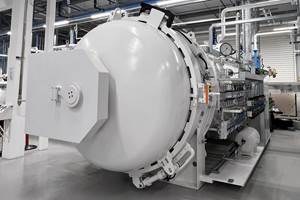The beauty of complication
CW Editor Jeff Sloan reflects on the challenge and fun of doing what CW does: chronicling the hard-to-explain, ever-changing evolution of composites manufacturing.
Many years ago, when I was in college and studying journalism, one of the first classes I took was on basic journalistic reporting. This is the task of collecting information about an event, person or place and then presenting that information in a clear, succinct, easy-to-read format for the audience. In 1987, when I took this class, the format was primarily print media, either newspaper or magazine — the concepts of digital media, social media and the Internet did not yet exist. Our reporting class focused on telling stories about the types of events we were likely to encounter as journalists: Public meetings, political speeches, crime scenes, etc.
One of my professors, eager to demonstrate the difficulty of using written language to clearly convey information, had us perform a simple exercise. We were given 10 minutes to write step-by-step instructions on how to tie a lace on a shoe. We were then instructed to trade our instructions with another student in the class, untie our own shoes and then follow the instructions we were given — to the letter — to re-tie our shoes. The question was simple: Could we write instructions well enough that a person could use them to tie shoe laces. The short answer is “no,” although some of us came pretty close. (If you doubt the difficulty of this assignment, I suggest you try it with your own friends and family, but don’t blame me for whatever arguments ensue).
This shoe lace-tying exercise has been brought to my mind often over the last several years as I edit the stories we publish in ÂÌñÏ×ÆÞ. I say this not to cast aspersions on CW’s writers and contributors — they are as well-versed in shoe-tying as they are in composites design, engineering and fabrication. I say this because CW operates in a composites industry that has proven admirably adept at generating complex, fast-evolving materials and processes that often are difficult to explain with the written word.
Take, for example, senior editor Ginger Gardiner’s story this month on filament winding. As she was doing research for this story, Ginger called me one morning about a new technology she’d just unearthed. It was, she said, developed by Daimler and dubbed FibreTEC3D. Here’s what Ginger said, as I remember it: “It’s not really filament winding, but it uses filament winding concepts. There’s no mandrel and no core, but it does use a towpreg-like material, which is wound around a series of vertical aluminum or steel pins by a multi-axis robot. It’s room-temperature cured, so no autoclave or oven.”
Got that?
Neither did I, until I backed Ginger up several sentences and sorted out what she was telling me. Fortunately, you can see, and read about, this system for yourself here, and you can understand immediately how inspired and creative it is.
Technology like what Ginger found is par for the course, and finding the words to explain it is a big part of what we do. For almost every story we publish, we look for some basic raw data covering a range of topics: Application requirements, design challenges, resin type, fiber type, fiber format, tooling type, manufacturing process, manufacturing parameters, finishing process, inspection protocol and assembly requirements. Then, we take what we get and put it all together to tell a story. It’s during the editing process that we work hardest to verify we are telling a story that makes sense and has value and utility for you — that we are, to complete the metaphor, helping you understand how that shoe is tied.
Rare, of course, is the story that sheds full, unbridled light on an application or process, but we like to think that we come close more often than not. Fortunately, we get a lot of practice, for there is no shortage of innovation and change in composites manufacturing for us to document and chronicle. And such a dynamic environment is not only great fun to be a part of, but it also drives the evolution of composites.
Related Content
Industrial composite autoclaves feature advanced control, turnkey options
CAMX 2024: Designed and built with safety and durability in mind, Akarmark delivers complete curing autoclave systems for a variety of applications.
Read MoreIndustrial curing autoclaves with advanced control systems
CAMX 2025: Turnkey Akarmak autoclaves support various composite curing needs with enhanced process control, international specification compliance and optimal heat distribution.
Read MoreBusch expands autoclave solutions
Busch announces its ability to address all autoclave, oven and associated composites manufacturing requirements following the acquisition of Vacuum Furnace Engineering.
Read MoreAdvanced autoclaves, ovens provide efficiency, precision and intelligent control
CAMX 2025: Olmar is highlighting its next-gen autoclaves and industrial ovens for composites curing to improve throughput, scale production and achieve tighter quality control.
Read MoreRead Next
Scaling up, optimizing the flax fiber composite camper
Greenlander’s Sherpa RV cab, which is largely constructed from flax fiber/bio-epoxy sandwich panels, nears commercial production readiness and next-generation scale-up.
Read MoreUltrasonic welding for in-space manufacturing of CFRTP
Agile Ultrasonics and NASA trial robotic-compatible carbon fiber-reinforced thermoplastic ultrasonic welding technology for space structures.
Read MoreCeramic matrix composites: Faster, cheaper, higher temperature
New players proliferate, increasing CMC materials and manufacturing capacity, novel processes and automation to meet demand for higher part volumes and performance.
Read More












